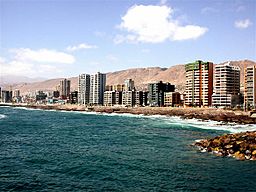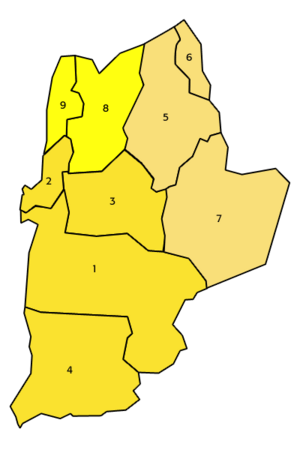Antofagasta Region facts for kids
The Antofagasta Region (also known as the II Región de Antofagasta) is a large area in Chile. It is one of Chile's 15 main parts, and it's the second biggest region in the country. To the east, it shares borders with Bolivia and Argentina. The main city and capital of this region is Antofagasta, which is also a port city.
Quick facts for kids Antofagasta (II Región de Antofagasta) |
|||
| Region of Chile | |||
|
The city of Antofagasta
|
|||
|
|||
| Country | |||
|---|---|---|---|
| Provinces | Antofagasta, El Loa, Tocopilla | ||
| Capital | Antofagasta | ||
| - coordinates | 23°38′S 70°24′W / 23.633°S 70.400°W | ||
| Highest point | Llullaico | ||
| - location | Puna de Atacama, Andes | ||
| - elevation | 6,739 m (22,110 ft) | ||
| Lowest point | Sea level | ||
| - elevation | 0 m (0 ft) | ||
| Area | 126,049.1 km² (48,668 sq mi) | ||
| Population | 622,640 (2015) | ||
| Density | 5 /km² (13 /sq mi) | ||
| Intendant | Valentín Volta Valencia | ||
| ISO 3166-2 | CL-AN | ||
Contents
A Look Back in Time
Early People and Settlements
Long ago, the Atacama people lived far from the coast in this region. They settled near a big dry salt lake called Salar de Atacama. They also lived near the Loa River and in oases across the high plains. The town of San Pedro de Atacama was a very important place for them.
A Change in Borders
This region used to be part of Bolivia. However, the War of the Pacific started in 1879. After this war, the Antofagasta Region became part of Chile.
Exploring the Geography
Where is Antofagasta?
The Antofagasta Region is located in northern Chile. To its north, it borders the Tarapacá Region. To the northeast, it shares a border with Bolivia. Argentina is to its southeast. The Atacama Region is to the south, and the vast Pacific Ocean lies to its west.
 |
Tarapacá region | Bolivia |  |
|
| Pacific Ocean | ||||
| Atacama region | Argentina |
Mountains and Rivers
The highest point in the region is the Llullaillaco volcano. It stands at about 6,739 meters (22,110 feet) tall. This volcano is right on the border with Argentina.
The only major river in the Antofagasta Region is the Loa River. It is the longest river in all of Chile. The Loa River flows for about 440 kilometers (273 miles).
Climate and Nature
The climate in the Antofagasta Region is very dry. It is mostly a desert climate. However, it can be a bit milder closer to the coast and in the highest mountains.
Because it's so dry, there is almost no vegetation here. The only places you might see plants are very close to the Loa River or in small oases like San Pedro de Atacama.
People and Cities
How Many People Live Here?
In 2015, about 622,640 people were estimated to live in the Antofagasta Region. This means there were about 4.9 people living in each square kilometer.
Major Cities
The largest cities in the region are the capitals of its three provinces. These are:
- Antofagasta: This is the biggest city, with about 285,255 people.
- Calama: This city has about 126,135 people.
- Tocopilla: About 23,352 people live here.
How the Region is Managed
The Antofagasta Region is divided into three main parts called provinces. Each province has its own capital city. These provinces are further divided into smaller areas called comunas.
| Provinces | Capital | Code | Comunas | Area (km²) |
Population 2002 |
|---|---|---|---|---|---|
| Antofagasta (021) |
Antofagasta | 02101 | 1 Antofagasta | 30,718.1 | 296,905 |
| 02102 | 2 Mejillones | 3,803.9 | 8,418 | ||
| 02103 | 3 Sierra Gorda | 12,886.4 | 2,356 | ||
| 02104 | 4 Taltal | 20,405.1 | 11,100 | ||
| Total of the Antofagasta province | 67,813.5 | 318,779 | |||
| El Loa (022) |
Calama | 02201 | 5 Calama | 15,596.9 | 138,402 |
| 02202 | 6 Ollagüe | 2,963.9 | 318 | ||
| 02203 | 7 San Pedro de Atacama | 23,438.8 | 4,969 | ||
| Total of the El Loa province | 41,999.6 | 143,689 | |||
| Tocopilla (023) |
Tocopilla | 02301 | 9 Tocopilla | 4,038.8 | 23,986 |
| 02302 | 8 María Elena | 12,197.2 | 7,530 | ||
| Total of the Tocopilla province | 16,236.0 | 31,516 | |||
| Total of the region | 126,049.1 | 493,984 | |||
Images for kids
-
The city of Antofagasta.
-
Atacama Desert, Vista before sunset.
See also
 In Spanish: Región de Antofagasta para niños
In Spanish: Región de Antofagasta para niños







